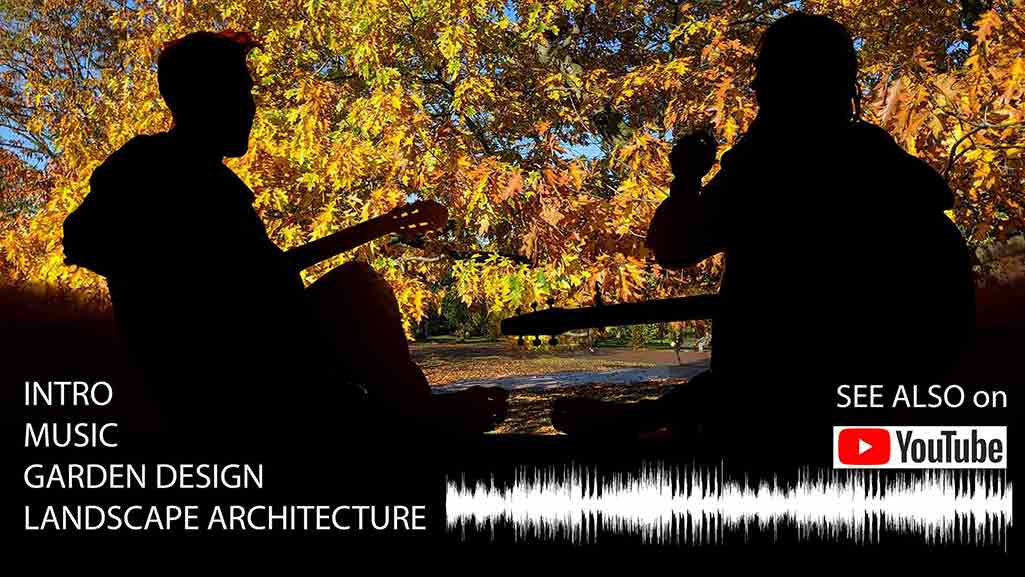Music and landscape architecture

Music and landscape architecture
Landscape architecture, garden design, music & art history: an introduction
Introduction to a set of 10 videos about how landscape architecture and garden design relate to the categories used by art history and musicology.
When Joseph Haydn asked his advice about a visit to London, Mozart replied ‘Papa! You have had no training for the great world, and you speak too few languages.’ Ah’ replied Haydn, ‘my language is understood all over the world!’ So is the language of landscape. In fact probably more so. Surveys of landscape visual quality around the world produce remarkably similar results. The natives of temperate climates, hot deserts and frozen wastes love their own countries tend to agree about which landscapes are beautiful, ordinary and ugly.
Considered as the art of composing buildings and pavings with water, landform water and vegetation, landscape architecture is one of the fine arts -and has been for over 10,000 years. If you accept the common definition of architecture as the design of buildings ‘for human habitation’ than landscape architecture is an older art than building architecture. This is because the first permanent structures were temples and burial sites (not habitations) which were located at significant positions in landscapes. The oldest structures of this type in the British Isles date from about 3,500BCE.
Part of the reason for landscape architecture not always being recognised as a fine art is that people are too concerned with the nineteenth century term ‘landscape architecture’. Ignoring this consideration, and defining landscape architecture as the composition of the five primary elements noted above, we can see that styles of landscape have developed in parallel with other developments in the histories of art and design.
Frederick Law Olmsted is often described as ‘the father of landscape architecture‘. This is a careless and troublesome error. But Olmsted was ‘the father of the landscape profession‘ – and a great man. He began to use the term ‘landscape architecture’ as a professional title in the 1860s. Since this was a high point in the Romantic Movement, the profession became associated with a Romantic approach to landscape design. Olmsted loved nature and wanted to create naturalistic places in cities. The great examples of his approach are Central Park in New York City, Prospect Park in Brooklyn (romantically linked to the Atlantic by Ocean Parkway) and the Emerald Necklace of parks and parkways in Boston. If asked ‘well, who were the fathers and mothers of landscape architecture?’ and pressed for an answer, I would say that they lived at least 6000 years before the invention of writing but that the oldest known practitioners of the art include Gilgamesh, Queen Hatshepsut and Senenmut.
The below links take you to a set of 10 videos in which this parallelism is (a) illustrated with about 25 images per video (2) further illustrated with style diagrams and typical plans, drawn with a consistent graphic style (3) accompanied with music representing the mood in which the places were designed. Since far too little is known about prehistoric and Roman music the melodies used for these videos is thematic only.
Prehistoric landscape architecture
https://youtu.be/vxeda0ADfxA
Roman landscape architecture
https://youtu.be/2y948DtxaV4
Medieval landscape architecture
https://youtu.be/TwmBEYDvZFE
Renaissance landscape architecture
https://youtu.be/O1xTE0lMynE
Baroque landscape architecture
https://youtu.be/2NUju1FoamE
Neoclassical landscape architecture
https://youtu.be/XyG83ntbb7A
Romantic landscape architecture
https://youtu.be/0Kl8wP6CGcg
Arts & Crafts landscape architecture
https://youtu.be/0Z5cL9EYI68
Abstract modern landscape architecture
https://youtu.be/uhqpcuI_U0M
Post-Abstract landscape architecture
https://youtu.be/Uj5WXcw0brg
